Tien-Hong Lo
Beyond Modality Limitations: A Unified MLLM Approach to Automated Speaking Assessment with Effective Curriculum Learning
Aug 18, 2025Abstract:Traditional Automated Speaking Assessment (ASA) systems exhibit inherent modality limitations: text-based approaches lack acoustic information while audio-based methods miss semantic context. Multimodal Large Language Models (MLLM) offer unprecedented opportunities for comprehensive ASA by simultaneously processing audio and text within unified frameworks. This paper presents a very first systematic study of MLLM for comprehensive ASA, demonstrating the superior performance of MLLM across the aspects of content and language use . However, assessment on the delivery aspect reveals unique challenges, which is deemed to require specialized training strategies. We thus propose Speech-First Multimodal Training (SFMT), leveraging a curriculum learning principle to establish more robust modeling foundations of speech before cross-modal synergetic fusion. A series of experiments on a benchmark dataset show MLLM-based systems can elevate the holistic assessment performance from a PCC value of 0.783 to 0.846. In particular, SFMT excels in the evaluation of the delivery aspect, achieving an absolute accuracy improvement of 4% over conventional training approaches, which also paves a new avenue for ASA.
The NTNU System at the S&I Challenge 2025 SLA Open Track
Jun 05, 2025Abstract:A recent line of research on spoken language assessment (SLA) employs neural models such as BERT and wav2vec 2.0 (W2V) to evaluate speaking proficiency across linguistic and acoustic modalities. Although both models effectively capture features relevant to oral competence, each exhibits modality-specific limitations. BERT-based methods rely on ASR transcripts, which often fail to capture prosodic and phonetic cues for SLA. In contrast, W2V-based methods excel at modeling acoustic features but lack semantic interpretability. To overcome these limitations, we propose a system that integrates W2V with Phi-4 multimodal large language model (MLLM) through a score fusion strategy. The proposed system achieves a root mean square error (RMSE) of 0.375 on the official test set of the Speak & Improve Challenge 2025, securing second place in the competition. For comparison, the RMSEs of the top-ranked, third-ranked, and official baseline systems are 0.364, 0.384, and 0.444, respectively.
Automated Speaking Assessment of Conversation Tests with Novel Graph-based Modeling on Spoken Response Coherence
Sep 11, 2024Abstract:Automated speaking assessment in conversation tests (ASAC) aims to evaluate the overall speaking proficiency of an L2 (second-language) speaker in a setting where an interlocutor interacts with one or more candidates. Although prior ASAC approaches have shown promising performance on their respective datasets, there is still a dearth of research specifically focused on incorporating the coherence of the logical flow within a conversation into the grading model. To address this critical challenge, we propose a hierarchical graph model that aptly incorporates both broad inter-response interactions (e.g., discourse relations) and nuanced semantic information (e.g., semantic words and speaker intents), which is subsequently fused with contextual information for the final prediction. Extensive experimental results on the NICT-JLE benchmark dataset suggest that our proposed modeling approach can yield considerable improvements in prediction accuracy with respect to various assessment metrics, as compared to some strong baselines. This also sheds light on the importance of investigating coherence-related facets of spoken responses in ASAC.
Zero-Shot Text-to-Speech as Golden Speech Generator: A Systematic Framework and its Applicability in Automatic Pronunciation Assessment
Sep 11, 2024Abstract:Second language (L2) learners can improve their pronunciation by imitating golden speech, especially when the speech that aligns with their respective speech characteristics. This study explores the hypothesis that learner-specific golden speech generated with zero-shot text-to-speech (ZS-TTS) techniques can be harnessed as an effective metric for measuring the pronunciation proficiency of L2 learners. Building on this exploration, the contributions of this study are at least two-fold: 1) design and development of a systematic framework for assessing the ability of a synthesis model to generate golden speech, and 2) in-depth investigations of the effectiveness of using golden speech in automatic pronunciation assessment (APA). Comprehensive experiments conducted on the L2-ARCTIC and Speechocean762 benchmark datasets suggest that our proposed modeling can yield significant performance improvements with respect to various assessment metrics in relation to some prior arts. To our knowledge, this study is the first to explore the role of golden speech in both ZS-TTS and APA, offering a promising regime for computer-assisted pronunciation training (CAPT).
An Effective Automated Speaking Assessment Approach to Mitigating Data Scarcity and Imbalanced Distribution
Apr 12, 2024



Abstract:Automated speaking assessment (ASA) typically involves automatic speech recognition (ASR) and hand-crafted feature extraction from the ASR transcript of a learner's speech. Recently, self-supervised learning (SSL) has shown stellar performance compared to traditional methods. However, SSL-based ASA systems are faced with at least three data-related challenges: limited annotated data, uneven distribution of learner proficiency levels and non-uniform score intervals between different CEFR proficiency levels. To address these challenges, we explore the use of two novel modeling strategies: metric-based classification and loss reweighting, leveraging distinct SSL-based embedding features. Extensive experimental results on the ICNALE benchmark dataset suggest that our approach can outperform existing strong baselines by a sizable margin, achieving a significant improvement of more than 10% in CEFR prediction accuracy.
A Hierarchical Context-aware Modeling Approach for Multi-aspect and Multi-granular Pronunciation Assessment
Jun 07, 2023



Abstract:Automatic Pronunciation Assessment (APA) plays a vital role in Computer-assisted Pronunciation Training (CAPT) when evaluating a second language (L2) learner's speaking proficiency. However, an apparent downside of most de facto methods is that they parallelize the modeling process throughout different speech granularities without accounting for the hierarchical and local contextual relationships among them. In light of this, a novel hierarchical approach is proposed in this paper for multi-aspect and multi-granular APA. Specifically, we first introduce the notion of sup-phonemes to explore more subtle semantic traits of L2 speakers. Second, a depth-wise separable convolution layer is exploited to better encapsulate the local context cues at the sub-word level. Finally, we use a score-restraint attention pooling mechanism to predict the sentence-level scores and optimize the component models with a multitask learning (MTL) framework. Extensive experiments carried out on a publicly-available benchmark dataset, viz. speechocean762, demonstrate the efficacy of our approach in relation to some cutting-edge baselines.
3M: An Effective Multi-view, Multi-granularity, and Multi-aspect Modeling Approach to English Pronunciation Assessment
Aug 19, 2022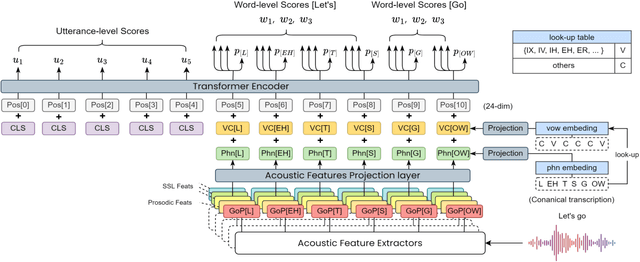
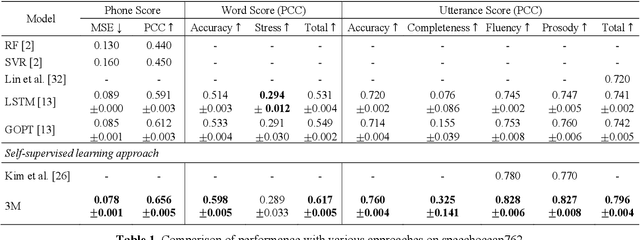
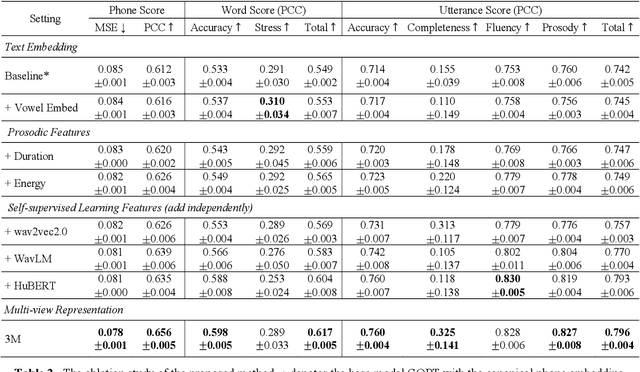

Abstract:As an indispensable ingredient of computer-assisted pronunciation training (CAPT), automatic pronunciation assessment (APA) plays a pivotal role in aiding self-directed language learners by providing multi-aspect and timely feedback. However, there are at least two potential obstacles that might hinder its performance for practical use. On one hand, most of the studies focus exclusively on leveraging segmental (phonetic)-level features such as goodness of pronunciation (GOP); this, however, may cause a discrepancy of feature granularity when performing suprasegmental (prosodic)-level pronunciation assessment. On the other hand, automatic pronunciation assessments still suffer from the lack of large-scale labeled speech data of non-native speakers, which inevitably limits the performance of pronunciation assessment. In this paper, we tackle these problems by integrating multiple prosodic and phonological features to provide a multi-view, multi-granularity, and multi-aspect (3M) pronunciation modeling. Specifically, we augment GOP with prosodic and self-supervised learning (SSL) features, and meanwhile develop a vowel/consonant positional embedding for a more phonology-aware automatic pronunciation assessment. A series of experiments conducted on the publicly-available speechocean762 dataset show that our approach can obtain significant improvements on several assessment granularities in comparison with previous work, especially on the assessment of speaking fluency and speech prosody.
Improving End-To-End Modeling for Mispronunciation Detection with Effective Augmentation Mechanisms
Oct 17, 2021



Abstract:Recently, end-to-end (E2E) models, which allow to take spectral vector sequences of L2 (second-language) learners' utterances as input and produce the corresponding phone-level sequences as output, have attracted much research attention in developing mispronunciation detection (MD) systems. However, due to the lack of sufficient labeled speech data of L2 speakers for model estimation, E2E MD models are prone to overfitting in relation to conventional ones that are built on DNN-HMM acoustic models. To alleviate this critical issue, we in this paper propose two modeling strategies to enhance the discrimination capability of E2E MD models, each of which can implicitly leverage the phonetic and phonological traits encoded in a pretrained acoustic model and contained within reference transcripts of the training data, respectively. The first one is input augmentation, which aims to distill knowledge about phonetic discrimination from a DNN-HMM acoustic model. The second one is label augmentation, which manages to capture more phonological patterns from the transcripts of training data. A series of empirical experiments conducted on the L2-ARCTIC English dataset seem to confirm the efficacy of our E2E MD model when compared to some top-of-the-line E2E MD models and a classic pronunciation-scoring based method built on a DNN-HMM acoustic model.
Towards Robust Mispronunciation Detection and Diagnosis for L2 English Learners with Accent-Modulating Methods
Aug 26, 2021



Abstract:With the acceleration of globalization, more and more people are willing or required to learn second languages (L2). One of the major remaining challenges facing current mispronunciation and diagnosis (MDD) models for use in computer-assisted pronunciation training (CAPT) is to handle speech from L2 learners with a diverse set of accents. In this paper, we set out to mitigate the adverse effects of accent variety in building an L2 English MDD system with end-to-end (E2E) neural models. To this end, we first propose an effective modeling framework that infuses accent features into an E2E MDD model, thereby making the model more accent-aware. Going a step further, we design and present disparate accent-aware modules to perform accent-aware modulation of acoustic features in a fine-grained manner, so as to enhance the discriminating capability of the resulting MDD model. Extensive sets of experiments conducted on the L2-ARCTIC benchmark dataset show the merits of our MDD model, in comparison to some existing E2E-based strong baselines and the celebrated pronunciation scoring based method.
Cross-sentence Neural Language Models for Conversational Speech Recognition
Jul 08, 2021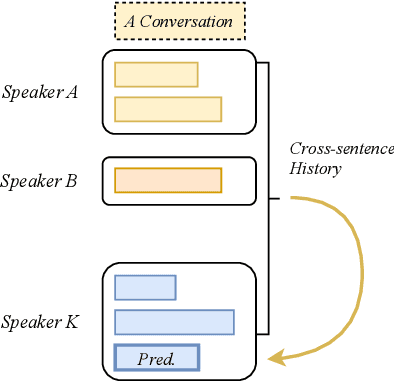
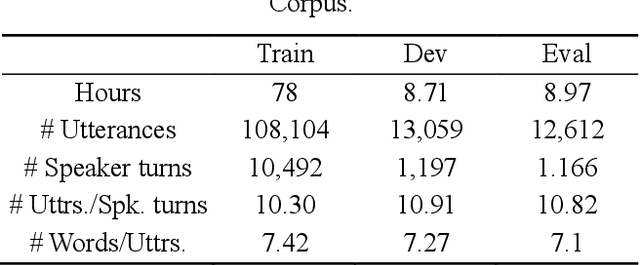
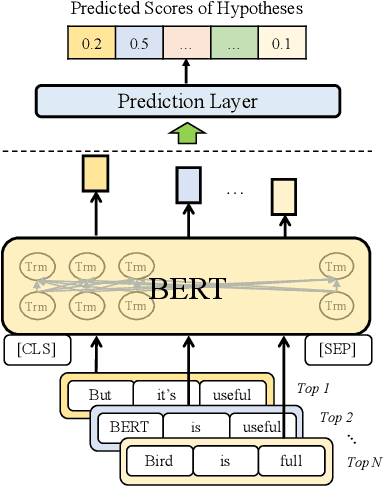
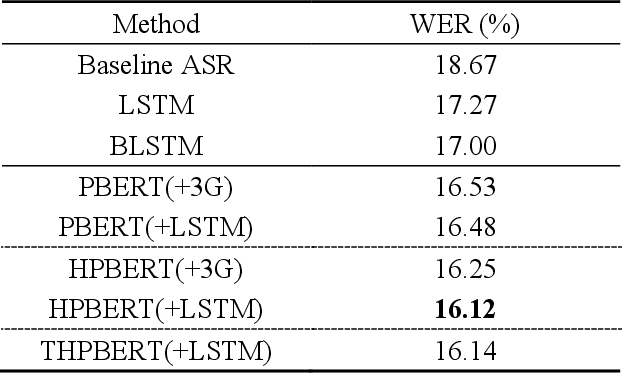
Abstract:An important research direction in automatic speech recognition (ASR) has centered around the development of effective methods to rerank the output hypotheses of an ASR system with more sophisticated language models (LMs) for further gains. A current mainstream school of thoughts for ASR N-best hypothesis reranking is to employ a recurrent neural network (RNN)-based LM or its variants, with performance superiority over the conventional n-gram LMs across a range of ASR tasks. In real scenarios such as a long conversation, a sequence of consecutive sentences may jointly contain ample cues of conversation-level information such as topical coherence, lexical entrainment and adjacency pairs, which however remains to be underexplored. In view of this, we first formulate ASR N-best reranking as a prediction problem, putting forward an effective cross-sentence neural LM approach that reranks the ASR N-best hypotheses of an upcoming sentence by taking into consideration the word usage in its precedent sentences. Furthermore, we also explore to extract task-specific global topical information of the cross-sentence history in an unsupervised manner for better ASR performance. Extensive experiments conducted on the AMI conversational benchmark corpus indicate the effectiveness and feasibility of our methods in comparison to several state-of-the-art reranking methods.
 Add to Chrome
Add to Chrome Add to Firefox
Add to Firefox Add to Edge
Add to Edge